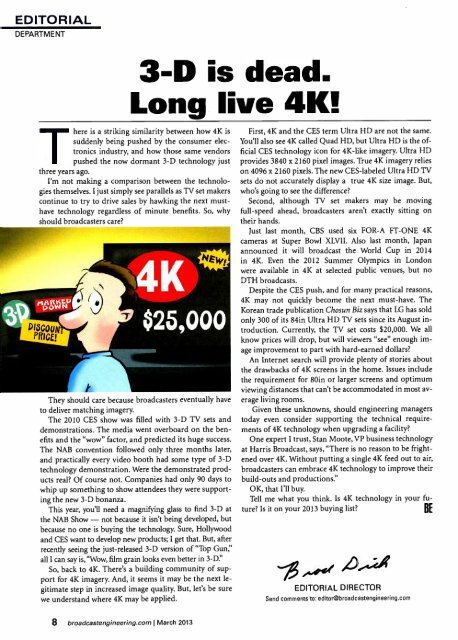ßroadcastEnsineerin - AmericanRadioHistory.Com
ßroadcastEnsineerin - AmericanRadioHistory.Com
ßroadcastEnsineerin - AmericanRadioHistory.Com
Create successful ePaper yourself
Turn your PDF publications into a flip-book with our unique Google optimized e-Paper software.
March<br />
EDITORIAL<br />
DEPARTMENT<br />
3 -D is dead.<br />
Long live 4K!<br />
There is a striking similarity between how 4K is<br />
suddenly being pushed by the consumer electronics<br />
industry, and how those same vendors<br />
pushed the now dormant 3 -D technology just<br />
three years ago.<br />
I'm not making a comparison between the technologies<br />
themselves. I just simply see parallels as TV set makers<br />
continue to try to drive sales by hawking the next must -<br />
have technology regardless of minute benefits. So, why<br />
should broadcasters care?<br />
They should care because broadcasters eventually have<br />
to deliver matching imagery.<br />
The 2010 CES show was filled with 3 -D TV sets and<br />
demonstrations. The media went overboard on the benefits<br />
and the "wow" factor, and predicted its huge success.<br />
The NAB convention followed only three months later,<br />
and practically every video booth had some type of 3 -D<br />
technology demonstration. Were the demonstrated products<br />
real? Of course not. <strong>Com</strong>panies had only 90 days to<br />
whip up something to show attendees they were supporting<br />
the new 3 -D bonanza.<br />
This year, you'll need a magnifying glass to find 3 -D at<br />
the NAB Show - not because it isn't being developed, but<br />
because no one is buying the technology. Sure, Hollywood<br />
and CES want to develop new products; I get that. But, after<br />
recently seeing the just - released 3 -D version of "Top Gun;'<br />
all I can say is, "Wow, film grain looks even better in 3 -D."<br />
So, back to 4K. There's a building community of support<br />
for 4K imagery. And, it seems it may be the next legitimate<br />
step in increased image quality. But, let's be sure<br />
we understand where 4K may be applied.<br />
First, 4K and the CES term Ultra HD are not the same.<br />
You'll also see 4K called Quad HD, but Ultra HD is the official<br />
CES technology icon for 4K -like imagery. Ultra HD<br />
provides 3840 x 2160 pixel images. True 4K imagery relies<br />
on 4096 x 2160 pixels. The new CES- labeled Ultra HD TV<br />
sets do not accurately display a true 4K size image. But,<br />
who's going to see the difference?<br />
Second, although TV set makers may be moving<br />
full -speed ahead, broadcasters aren't exactly sitting on<br />
their hands.<br />
Just last month, CBS used six FOR -A FT -ONE 4K<br />
cameras at Super Bowl XLVII. Also last month, Japan<br />
announced it will broadcast the World Cup in 2014<br />
in 4K. Even the 2012 Summer Olympics in London<br />
were available in 4K at selected public venues, but no<br />
DTH broadcasts.<br />
Despite the CES push, and for many practical reasons,<br />
4K may not quickly become the next must -have. The<br />
Korean trade publication Chosun Biz says that LG has sold<br />
only 300 of its 84in Ultra HD TV sets since its August introduction.<br />
Currently, the TV set costs $20,000. We all<br />
know prices will drop, but will viewers "see" enough image<br />
improvement to part with hard -earned dollars?<br />
An Internet search will provide plenty of stories about<br />
the drawbacks of 4K screens in the home. Issues include<br />
the requirement for 80in or larger screens and optimum<br />
viewing distances that can't be accommodated in most average<br />
living rooms.<br />
Given these unknowns, should engineering managers<br />
today even consider supporting the technical requirements<br />
of 4K technology when upgrading a facility?<br />
One expert I trust, Stan Moote, VP business technology<br />
at Harris Broadcast, says, "There is no reason to be frightened<br />
over 4K. Without putting a single 4K feed out to air,<br />
broadcasters can embrace 4K technology to improve their<br />
build -outs and productions?'<br />
OK, that I'll buy.<br />
Tell me what you think. Is 4K technology in your future?<br />
Is it on your 2013 buying list?<br />
EDITORIAL DIRECTOR<br />
Send comments to: editor ©broadcastengineering.com<br />
BE<br />
8 broadcastengineering.com<br />
I<br />
2013
















